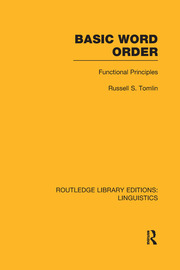This book examines the frequencies of the six possible basic word (or constituent) orders (SOV, SVO, VSO, VOS, OSV, OVS) provides a typologically grounded explanation for those frequencies in terms of three independent, functional principles of linguistic organization.
From a database of nearly 1,000 languages and their basic constituent orders, a sample of 400 languages was produced that is statistically representative of both the genetic and areal distributions of the world’s languages. This sample reveals the following relative frequencies (in order from high to low) of basic constituent order types: (1) SOV and SVO, (2) VSO, (3) VOS and OVS, (4) OSV.
It is argued that these relative frequencies can be explained to be the result of the possible interactions of three fundamental functional principles of linguistic organization. Principle 1, the thematic information principle, specifies that initial position is the cross-linguistically favoured position for clause-level thematic information. Principle 2, the verb-object bonding principle, describes the cross-linguistic tendency for a transitive verb and its object to form a more tightly integrated unit, syntactically and semantically, than does a transitive verb and its subject. Principle 3, the animated principle, describes the cross-linguistic tendency for semantic arguments which are either more animate or more agentive to occur earlier in the clause. Each principle is motivated independently of the others, drawing on cross-linguistic data from more than 80 genetically and typologically diverse languages.
Given these three independently motivated functional principles, it is argued that the relative frequency of basic constituent order types is due to the tendency for the three principles to be maximally realized in the world’s languages. SOV and SVO languages are typologically most frequent because such basic orders reflect all three principles. The remaining orders occur less frequently because they reflect fewer of the principles.
The 1,000-language database and the genetic and areal classification frames are published as appendices to the volume.
چکیده فارسی
این کتاب بسامدهای شش مرتبه اصلی کلمه (یا مؤلفه) ممکن (SOV، SVO، VSO، VOS، OSV، OVS) را بررسی میکند، توضیحی مبتنی بر گونهشناسی برای آن فرکانسها بر اساس سه اصل مستقل و کاربردی زبانشناختی ارائه میکند. سازمان.
از پایگاه داده ای از نزدیک به 1000 زبان و ردیف های اصلی تشکیل دهنده آنها، نمونه ای از 400 زبان تولید شد که از نظر آماری نماینده توزیع ژنتیکی و منطقه ای زبان های جهان است. این نمونه فرکانسهای نسبی زیر را (به ترتیب از زیاد به پایین) انواع مرتبه اصلی تشکیل دهنده نشان میدهد: (1) SOV و SVO، (2) VSO، (3) VOS و OVS، (4) OSV.
استدلال می شود که این بسامدهای نسبی را می توان به عنوان نتیجه تعاملات احتمالی سه اصل عملکردی اساسی سازمان زبانی توضیح داد. اصل 1، اصل اطلاعات موضوعی، مشخص میکند که موقعیت اولیه، موقعیت مطلوب بین زبانی برای اطلاعات موضوعی سطح بند است. اصل 2، اصل پیوند فعل و مفعول، گرایش میان زبانی را برای یک فعل متعدی و مفعول آن برای تشکیل واحد یکپارچهتر، از لحاظ نحوی و معنایی، توصیف میکند تا یک فعل متعدی و فاعل آن. . اصل 3، اصل متحرک، گرایش میان زبانی را برای استدلالهای معنایی توصیف میکند که یا متحرکتر یا عاملتر هستند که در ابتدای این عبارت اتفاق میافتند. هر اصل مستقل از سایرین برانگیخته می شود و از داده های میان زبانی از بیش از 80 زبان مختلف ژنتیکی و گونه شناسی استفاده می کند.
با توجه به این سه اصل عملکردی با انگیزه مستقل، استدلال میشود که فراوانی نسبی انواع ترتیب تشکیلدهنده اصلی به دلیل تمایل این سه اصل به حداکثر تحقق در زبانهای جهان است. زبانهای SOV و SVO از نظر گونهشناسی متداولترین هستند زیرا چنین دستورات اساسی هر سه اصل را منعکس میکنند. سفارشهای باقیمانده کمتر اتفاق میافتند، زیرا اصول کمتری را منعکس میکنند.
پایگاه داده 1000 زبانی و چارچوبهای طبقهبندی ژنتیکی و منطقهای به عنوان ضمیمههای جلد منتشر شدهاند.
ادامه ...
بستن ...










